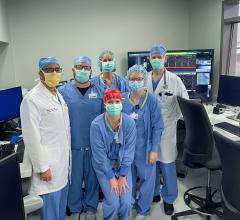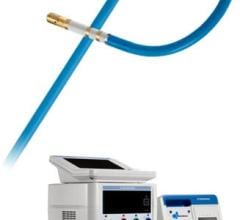July 8, 2014 — Use of catheter ablation is not only beneficial for treating atrial flutter but also can significantly reduce hospital visits — both inpatient and emergency — and lower the risk for atrial fibrillation, according to research by the University of California San Francisco (UCSF).
The study is in the July issue of PLOS ONE and available online.
"We've seen firsthand in our clinical experience that atrial flutter is difficult to control with drugs, even more than atrial fibrillation," said senior author Gregory Marcus, M.D., director of clinical research in the UCSF Division of Cardiology. "Based on our study findings, physicians and patients need to be educated that atrial flutter can be readily cured through catheter ablation, and the procedure may reduce the risk for atrial fibrillation."
Atrial flutter (AFL) is a common abnormal heart rhythm similar to atrial fibrillation (AF). In AF, electrical impulses are triggered from many areas in and around the upper chambers (atria) of the heart instead of just one area. This activity is chaotic, and the atrial walls quiver rather than contract normally in moving blood to the lower chambers (ventricles). In AFL, the electrical activity is more coordinated into one rapid circuit, but the atria contract very rapidly.
"The use of catheter ablation for AFL is very effective and can significantly reduce hospital visits and demand on health care services," Marcus said. "It's a safe procedure we frequently perform, even on people in their 90s."
AFL can be treated through catheter ablation, especially if medications or electrical cardioversion (shocking the heart back to a normal rhythm) are unsuccessful. In the minimally invasive procedure, thin, flexible wires called catheters are inserted into a vein and threaded into the heart. The tip of the catheter either delivers heat or extreme cold to destroy tissue responsible for the initiation and/or perpetuation of the abnormal heart rhythm.
Ablation has a high rate of success and symptom improvement, but little has been known if the procedure also results in reduced use of hospital services and lower risk for atrial fibrillation or stroke in a large, real-world population. Small studies have been limited to single academic centers or carefully selected randomized trial participants, and results have not been replicated through subsequent studies.
Using the California Healthcare Cost and Utilization Project database of community and academic hospitals across California, Marcus and his colleagues identified patients undergoing AFL ablation from 2005-2009. Of the 33,004 patients with an AFL diagnosis (in the absence of an AF diagnosis) and who were observed an average of 2.1 years, 2,733 (8.2 percent) received a catheter ablation.
Performing a multivariate analysis adjusting for patient demographics and comorbidities, the UCSF researchers determined AFL catheter ablation reduced the risk for overall hospital-based health care by 6 percent, inpatient hospitalization by 12 percent and emergency department visits by 40 percent.
"We think our most convincing finding was that health care utilization significantly dropped after vs. before the AFL ablation within the same patients," said study first author Thomas Dewland, M.D., cardiac electrophysiology fellow at UCSF.
Ablation also led to an 11 percent reduction in risk for health care for AF but only a negligible drop in risk for acute stroke.
Patient demographics included age, gender, race, insurance and income. Comorbidities included hypertension, diabetes, coronary artery disease, heart failure, remote history of cardiothoracic surgery, valvular heart disease, pulmonary disease, chronic kidney disease, neurologic disease and AF.
According to American College of Cardiology/American Heart Assn. guidelines issued in 2003, catheter ablation to treat a first episode of AFL currently is only a Class IIa recommendation, Class I after arrhythmia recurrence. In Class IIa, the weight of evidence or opinion favors the procedure or treatment. In Class I, there is evidence for and/or general agreement that the procedure or treatment is useful and effective.
"However, we believe our study findings, in combination with the previous literature and our clinical experience, are sufficient to support catheter ablation as first-line treatment for AFL," Marcus said.
For more information: www.ucsf.edu


 October 30, 2024
October 30, 2024 








